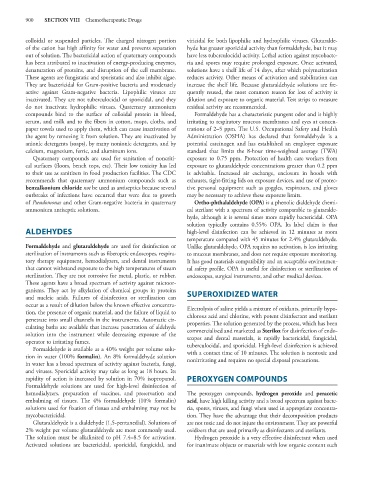Page 914 - Basic _ Clinical Pharmacology ( PDFDrive )
P. 914
900 SECTION VIII Chemotherapeutic Drugs
colloidal or suspended particles. The charged nitrogen portion viricidal for both lipophilic and hydrophilic viruses. Glutaralde-
of the cation has high affinity for water and prevents separation hyde has greater sporicidal activity than formaldehyde, but it may
out of solution. The bactericidal action of quaternary compounds have less tuberculocidal activity. Lethal action against mycobacte-
has been attributed to inactivation of energy-producing enzymes, ria and spores may require prolonged exposure. Once activated,
denaturation of proteins, and disruption of the cell membrane. solutions have a shelf life of 14 days, after which polymerization
These agents are fungistatic and sporistatic and also inhibit algae. reduces activity. Other means of activation and stabilization can
They are bactericidal for Gram-positive bacteria and moderately increase the shelf life. Because glutaraldehyde solutions are fre-
active against Gram-negative bacteria. Lipophilic viruses are quently reused, the most common reason for loss of activity is
inactivated. They are not tuberculocidal or sporicidal, and they dilution and exposure to organic material. Test strips to measure
do not inactivate hydrophilic viruses. Quaternary ammonium residual activity are recommended.
compounds bind to the surface of colloidal protein in blood, Formaldehyde has a characteristic pungent odor and is highly
serum, and milk and to the fibers in cotton, mops, cloths, and irritating to respiratory mucous membranes and eyes at concen-
paper towels used to apply them, which can cause inactivation of trations of 2–5 ppm. The U.S. Occupational Safety and Health
the agent by removing it from solution. They are inactivated by Administration (OSHA) has declared that formaldehyde is a
anionic detergents (soaps), by many nonionic detergents, and by potential carcinogen and has established an employee exposure
calcium, magnesium, ferric, and aluminum ions. standard that limits the 8-hour time-weighted average (TWA)
Quaternary compounds are used for sanitation of noncriti- exposure to 0.75 ppm. Protection of health care workers from
cal surfaces (floors, bench tops, etc). Their low toxicity has led exposure to glutaraldehyde concentrations greater than 0.2 ppm
to their use as sanitizers in food production facilities. The CDC is advisable. Increased air exchange, enclosure in hoods with
recommends that quaternary ammonium compounds such as exhausts, tight-fitting lids on exposure devices, and use of protec-
benzalkonium chloride not be used as antiseptics because several tive personal equipment such as goggles, respirators, and gloves
outbreaks of infections have occurred that were due to growth may be necessary to achieve these exposure limits.
of Pseudomonas and other Gram-negative bacteria in quaternary Ortho-phthalaldehyde (OPA) is a phenolic dialdehyde chemi-
ammonium antiseptic solutions. cal sterilant with a spectrum of activity comparable to glutaralde-
hyde, although it is several times more rapidly bactericidal. OPA
solution typically contains 0.55% OPA. Its label claim is that
ALDEHYDES high-level disinfection can be achieved in 12 minutes at room
temperature compared with 45 minutes for 2.4% glutaraldehyde.
Formaldehyde and glutaraldehyde are used for disinfection or Unlike glutaraldehyde, OPA requires no activation, is less irritating
sterilization of instruments such as fiberoptic endoscopes, respira- to mucous membranes, and does not require exposure monitoring.
tory therapy equipment, hemodialyzers, and dental instruments It has good materials compatibility and an acceptable environmen-
that cannot withstand exposure to the high temperatures of steam tal safety profile. OPA is useful for disinfection or sterilization of
sterilization. They are not corrosive for metal, plastic, or rubber. endoscopes, surgical instruments, and other medical devices.
These agents have a broad spectrum of activity against microor-
ganisms. They act by alkylation of chemical groups in proteins SUPEROXIDIZED WATER
and nucleic acids. Failures of disinfection or sterilization can
occur as a result of dilution below the known effective concentra- Electrolysis of saline yields a mixture of oxidants, primarily hypo-
tion, the presence of organic material, and the failure of liquid to chlorous acid and chlorine, with potent disinfectant and sterilant
penetrate into small channels in the instruments. Automatic cir- properties. The solution generated by the process, which has been
culating baths are available that increase penetration of aldehyde commercialized and marketed as Sterilox for disinfection of endo-
solution into the instrument while decreasing exposure of the scopes and dental materials, is rapidly bactericidal, fungicidal,
operator to irritating fumes. tuberculocidal, and sporicidal. High-level disinfection is achieved
Formaldehyde is available as a 40% weight per volume solu-
tion in water (100% formalin). An 8% formaldehyde solution with a contact time of 10 minutes. The solution is nontoxic and
nonirritating and requires no special disposal precautions.
in water has a broad spectrum of activity against bacteria, fungi,
and viruses. Sporicidal activity may take as long as 18 hours. Its
rapidity of action is increased by solution in 70% isopropanol. PEROXYGEN COMPOUNDS
Formaldehyde solutions are used for high-level disinfection of
hemodialyzers, preparation of vaccines, and preservation and The peroxygen compounds, hydrogen peroxide and peracetic
embalming of tissues. The 4% formaldehyde (10% formalin) acid, have high killing activity and a broad spectrum against bacte-
solutions used for fixation of tissues and embalming may not be ria, spores, viruses, and fungi when used in appropriate concentra-
mycobactericidal. tion. They have the advantage that their decomposition products
Glutaraldehyde is a dialdehyde (1,5-pentanedial). Solutions of are not toxic and do not injure the environment. They are powerful
2% weight per volume glutaraldehyde are most commonly used. oxidizers that are used primarily as disinfectants and sterilants.
The solution must be alkalinized to pH 7.4–8.5 for activation. Hydrogen peroxide is a very effective disinfectant when used
Activated solutions are bactericidal, sporicidal, fungicidal, and for inanimate objects or materials with low organic content such

